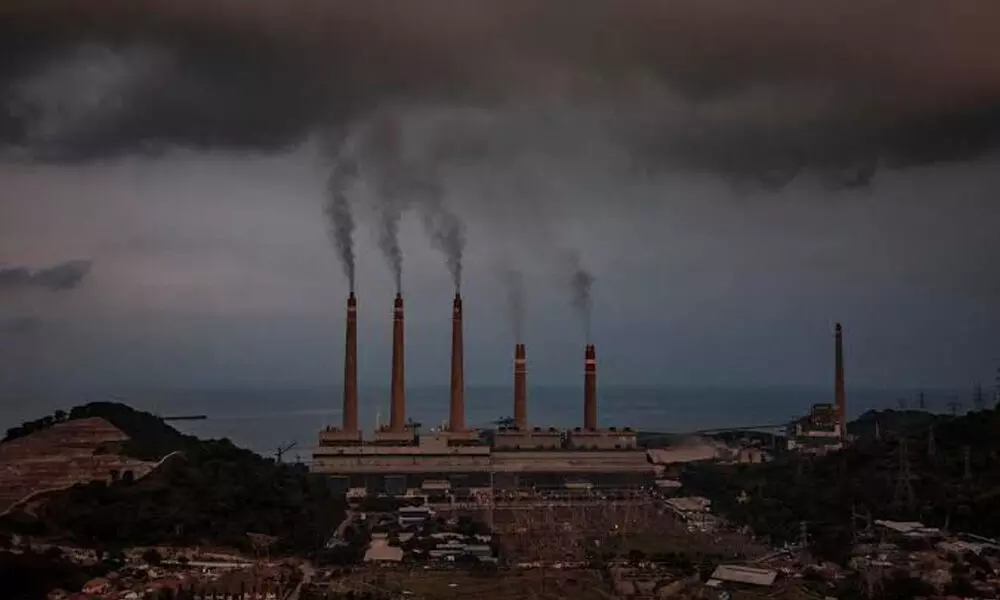Live
- All you need to know about PAN 2.0
- Akasa Air redefines travel experience with industry-first offerings
- MP: Residents stage protests against liquor shop in Indore
- Telugu Actor Shri Tej Booked for Alleged Cheating and False Promise of Marriage in Live-in Relationship
- Toyota Kirloskar Motor Celebrates 1 Lakh Urban Cruiser Hyryder on Indian Road
- MLS: New York City FC part ways with head coach Nick Cushing
- Delhi CM says Centre cutting AAP voters’ names from rolls, BJP hits back
- Hyderabad Metro Rail Phase-II Works to Begin in Old City in January 2025
- Odisha: 668 persons killed in human-elephant conflicts in last three years
- DEFENDER JOURNEYS: TO EMBARK ON ITS THIRD EDITION FROM NOVEMBER 2024
Just In
Sulfur dioxide emissions show decline in India: Report


Sulfur dioxide emissions show decline in India: Report
For the first time in four years India’s sulfur dioxide (SO2) emissions recorded a significant decline of approximately 6% in 2019 compared to 2018, reveals an annual analysis from Greenpeace India and the Centre for Research on Energy and Clean Air
Bengaluru: For the first time in four years India's sulfur dioxide (SO2) emissions recorded a significant decline of approximately 6% in 2019 compared to 2018, reveals an annual analysis from Greenpeace India and the Centre for Research on Energy and Clean Air (CREA).
However, India continues to occupy top emitter's position for the fifth consecutive year. The report ranks the world's biggest emitters of sulfur dioxide, a poisonous air pollutant that increases the risk of stroke, heart disease, lung cancer, and premature death.
Earlier in September this year, a study by Climate Risk Horizon, suggested that, if 54 coal plants that are 20 years or more, located across 11 states (Andhra Pradesh, Bihar, Chhattisgarh, Gujarat, Karnataka, Madhya Pradesh, Maharashtra, Tamil Nadu, Telangana, Uttar Pradesh and West Bengal) could be shut down over the next two years, it would yield savings of up to Rs 53,000 crore ($7.2 billion) over five years for the discoms of these states.This could make up for over 50% of the dues of the discoms.
These savings would come from two streams--avoiding the installation cost of expensive pollution control technology that has to be in place by 2022 to meet the government-mandated 2015 air quality standards and using cheaper options to replace the costly electricity bought from the old plants under long-term purchase agreements, said the study released on September 3.
As on April 30, Indian discoms owed over Rs 1 lakh crore ($13.65 billion) to power generation companies, according to the Ministry of Power data. Of this, Rs 54,695 crore ($7.47 billion) could be traced to the 11 states analysed by CRH--Andhra Pradesh, Bihar, Chhattisgarh, Gujarat, Karnataka, Madhya Pradesh, Maharashtra, Tamil Nadu, Telangana, Uttar Pradesh and West Bengal.
In 2019, India emitted 21% of global anthropogenic (human-made) SO2 emissions, nearly double that of second-ranked global emitter, Russia. China occupies the third position.
As per the latest report, the biggest emission hotspots, are thermal power stations at Singrauli, Neyveli, Sipat, Mundra, Korba, Bonda, Tamnar, Talcher, Jharsuguda, Kutch, Surat, Chennai, Ramagundam, Chandrapur, Visakhapatnam and Koradi.
"We are seeing a reduction in SO2 emissions in the top three emitter countries. In India, we're getting a glimpse of how reduction in coal usage can impact air quality and health. In 2019, renewable energy capacity expanded, coal dependency decreased and we saw a corresponding improvement in air quality. But our air is still far from safe. We must speed up the energy transition away from coal and towards renewables, for our health and economy.
While ensuring just transition of energy, with the help of decentralized renewable sources, we need to prioritize access to electricity for the poor," says Avinash Chanchal, Climate Campaigner, Greenpeace India.
In 2015, the Ministry of Environment, Forest and Climate Change (MoEF&CC) introduced SO2 emission limits for coal power stations. But power plants missed the initial deadline of December 2017 for the installation of FGD units. Though the deadline was extended till 2022, as of June 2020 most of the power plants are operating without compliance to standards. Five years after setting the SO2 emission limits, the Indian government has decided to shut down non-compliant thermal power stations and has also allocated Rs 4,400 crore to tackle the air pollution crisis.
"SO2 emissions are affecting the health of millions of people directly and worse through converting to PM2.5. The most efficient and easiest way to reduce PM2.5 levels is to install FGD and reduce SO2 emissions from power plants as they form a significant fraction of total PM2.5 pollution at different locations across the country. Every single day delay in implementation of prescribed norms and not installing the FGD system is causing huge health and economic damage to our society, it's time the offenders/non-complying power plants are pulled up for inaction and damage to the society to ensure better implementation moving ahead," says Sunil Dahiya, Analyst, Centre for Research on Energy and Clean Air (CREA).

© 2024 Hyderabad Media House Limited/The Hans India. All rights reserved. Powered by hocalwire.com






